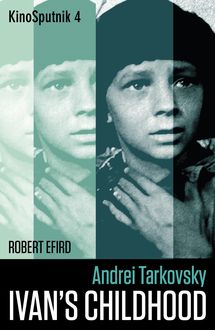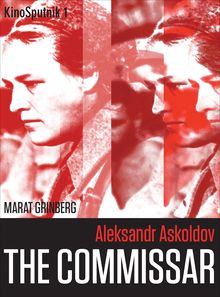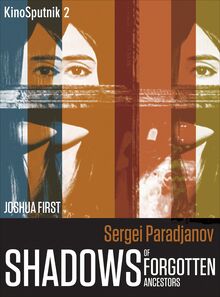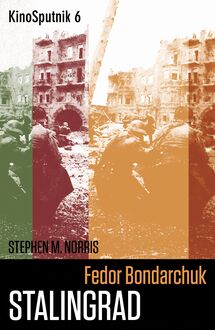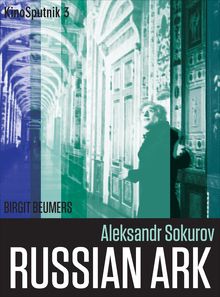-
 Univers
Univers
-
 Ebooks
Ebooks
-
 Livres audio
Livres audio
-
 Presse
Presse
-
 Podcasts
Podcasts
-
 BD
BD
-
 Documents
Documents
-
- Cours
- Révisions
- Ressources pédagogiques
- Sciences de l’éducation
- Manuels scolaires
- Langues
- Travaux de classe
- Annales de BEP
- Etudes supérieures
- Maternelle et primaire
- Fiches de lecture
- Orientation scolaire
- Méthodologie
- Corrigés de devoir
- Annales d’examens et concours
- Annales du bac
- Annales du brevet
- Rapports de stage
La lecture à portée de main
Vous pourrez modifier la taille du texte de cet ouvrage
Découvre YouScribe en t'inscrivant gratuitement
Je m'inscrisDécouvre YouScribe en t'inscrivant gratuitement
Je m'inscrisEn savoir plus
Vous pourrez modifier la taille du texte de cet ouvrage
En savoir plus

Description
Note on transliteration
Acknowledgements
KinoSputniks general editors’ preface
List of illustrations
Production credits
Plot summary
Chapter 1: Introduction
Chapter 2: Historical context and production history
Chapter 3: Film analysis
Chapter 4: Reception
Chapter 5: Conclusion: Fifty years later
Sujets
Informations
| Publié par | Intellect Books |
| Date de parution | 10 novembre 2016 |
| Nombre de lectures | 0 |
| EAN13 | 9781783207114 |
| Langue | English |
Informations légales : prix de location à la page 0,1300€. Cette information est donnée uniquement à titre indicatif conformément à la législation en vigueur.
Extrait
First published in the UK in 2016 by
Intellect, The Mill, Parnall Road, Fishponds, Bristol, BS16 3JG, UK
First published in the USA in 2016 by
Intellect, The University of Chicago Press, 1427 E. 60th Street,
Chicago, IL 60637, USA
Copyright © 2016 Intellect Ltd
All rights reserved. No part of this publication may be reproduced, stored in a retrieval system, or transmitted, in any form or by any means, electronic, mechanical, photocopying, recording, or otherwise, without written permission.
A catalogue record for this book is available from the British Library.
Copy-editor: Michael Eckhardt
Cover designer: Emily Dann
Production manager: Matthew Floyd
Typesetting: Contentra Technologies
ISBN: 978-1-78320-709-1
ePDF: 978-1-78320-710-7
ePUB: 978-1-78320-711-4
KinoSputniks:
Series Editors: Birgit Beumers & Richard Taylor
Editorial Board: Julian Graffy, Denise Youngblood
Current titles:
Aleksandr Askoldov: The Commissar by Marat Grinberg
Sergei Paradjanov: Shadows of Forgotten Ancestors by Joshua First
Aleksandr Sokurov: Russian Ark by Birgit Beumers
CONTENTS
Note on transliteration
Acknowledgements
KinoSputniks general editors’ preface
List of illustrations
Production credits
Plot summary
Chapter 1: Introduction
Chapter 2: Historical context and production history
Chapter 3: Film analysis
Chapter 4: Reception
Chapter 5: Conclusion: Fifty years later
References
Notes
Note on transliteration
In this text, which contains both Russian and Ukrainian names and places, I use the Library of Congress system for transliterating from the Cyrillic to the Latin alphabet. I have departed from this system when a name has an accepted English spelling (e.g. Paradjanov instead of Paradzhanov; Tarkovsky instead of Tarkovskii; Eisenstein instead of Eizenshtein).
During the Soviet era, Ukrainian names were usually transliterated into English in their Russian variant; the film studied in this volume, however, was made in Ukrainian and therefore the names have been rendered using the Library of Congress system for Ukrainian. Place names, however, are given in the form that corresponds to the language of publication (in the bibliography) or their common English variant at the time (Kiev for Kyiv; L'vov for L'viv, etc.).
Acknowledgements
First and foremost, I am extremely grateful to Richard Taylor and Birgit Beumers for offering me the opportunity to write a book in the Kino Sputnik series, and for all of their help and patience along the way. Moreover, their scholarship, along with that of Denise Youngblood and Josephine Woll, inspired me to pursue the study of Soviet cinema almost twenty years ago. Most recently, James Steffen has helped me out tremendously with the present project, and his scholarship on Sergei Paradjanov continues to inspire my own work.
I owe an enormous debt of thanks to the many institutions and individuals who facilitated my research and writing. At the University of Michigan, the Center for Russian and East European Studies funded my study of the Ukrainian language, in addition to my first research trip to Kyiv in 2004. The Departments of History and Screen Arts and Cultures, in addition to the Rackham School of Graduate Studies, aided me immeasurably at key moments in my archival research. I conducted the bulk of my research in Kyiv and Moscow on an IREX fellowship in 2005–06. At the University of Mississippi, I received a summer research grant in 2015 that allowed me to complete the manuscript.
In Kyiv, I would like to thank the staff at the Central State Archive Museum of Literature and Art of Ukraine for going above and beyond their call of duty in getting essential research materials to me. I am grateful to have met Svetlana and Miron Petrovskii, who not only shared their flat during part of my research, but also for their personal recollections about Shadows of Forgotten Ancestors during its premiere on 4 September 1965.
While such support and inspiration was essential for completing this project, all views expressed in it, including faulty ones, are entirely my own.
KinoSputniks general editors’ preface
This series intends to examine closely some key films to have emerged from the history of Russian and Soviet cinema. Continuing from KinoFiles (2000–2010), the KinoSputniks are intended for film enthusiasts and students alike, combining scholarship with a style of writing that is accessible to a broad readership. Each KinoSputnik is written by a specialist in the field of Russian and/or film studies, and examines the production, context and reception of the film, whilst defining the film’s place in its national context and in the history of world cinema.
Birgit Beumers & Richard Taylor Wales, June 2016
List of illustrations
1. Iakutovych’s sketches of Hutsul faces. From Novyny kinoekrana , 5 (1965).
2. Larisa Kadochnikova in Ukrainian folk costume. Courtesy of the Aleksandr Dovzhenko National Centre, Kyiv.
3. A tree falls on Oleksa. Still from the film.
4. Drymba player. Still from the film.
5. The frame drenched in blood. Still from the film.
6. ‘Wild Horses of Fire’. Still from the film.
7. Ethnographic tableaux. Still from the film.
8. The highland pasture. Still from the film.
9. Marichka falls to her death. Still from the film.
10. Woman in black falls to her death. Still from Battleship Potemkin (Eisenstein, 1925).
11. Ivanko discovers Marichka’s body washed ashore. Still from the film.
12. Ivanko in decline. Still from the film.
13. Myko superimposed on the crucifix. Still from the film.
14. Palahna on the horse, with red umbrella. Still from the film.
15. Ivanko and Palahna enyoked. Still from the film.
16. Ivanko from the depths. Still from the film.
17. Ivanko as the Grim Reaper. Still from the film.
18. Marichka’s apparition in the window. Still from the film.
19. Palahna begins her incantation. Still from the film.
20. Illienko’s trick photography: Iura the sorcerer performing magic. Still from the film.
21. A Hutsul party. Still from the film.
22. Curious Jewish children in the tavern. Still from the film.
23. A woman catches an apple at Ivanko’s funeral. Still from the film.
24. Children’s faces in the window panes. Still from the film.
25. Entrance to the Shadows of Forgotten Ancestors Museum, Verkhovyna, Ukraine. Photograph by EugeneB. 1
Production credits Production company: Dovzhenko Film Studios, 1964 Release date: 4 September 1965 (premiere in Kiev) Director: Sergei Paradjanov Screenplay: Sergei Paradjanov and Ivan Chendei, based on Mykhailo Kotsiubyns'kyi’s novella ‘Tini zabutykh predkiv’/‘Shadows of Forgotten Ancestors’ Assistant Directors: Volodymyr Luhovs'kyi and Volodymyr Davydov Cinematographer: Iurii Illienko Production Design: Heorhii Iakutovych and Mykhailo Rakovs'kyi Composer: Myroslav Skoryk Editor: Maria Ponomarenko Costume Design: Lidiia Baikova Screenplay Editor: Oleksandr Syzonenko Artistic Consultant: Fedir Manailo Running time: 92 minutes
CAST Ivanko Ivan Mykolaichuk; Ihor Dziura (child) Marichka Larisa Kadochnikova; Valentyna Hlyn'ko (child) Palahna Tat'iana Bestaeva Iura the sorcerer Spartak Bagashvili Head shepherd Mykola Hryn'ko Myko Leonid Engibarov Ivanko’s mother Nina Alisova Ivanko’s father (Petro) Oleksandr Hai Marichka’s father (Onufrii) Oleksandr Raidanov Marichka’s mother (Paraska) Neonila Hnepovs'ka
SCREENINGS AT INTERNATIONAL FILM FESTIVALS (AND AWARDS)
Mar del Plata (Argentina) International Film Festival, 1965 (Best Production)
San Sebastian International Film Festival, 1965
Venice International Film Festival, 1965
San Francisco International Film Festival, 1965
BFI London Film Festival, 1966
Thessaloniki International Film Festival, 1966 (Best Director)
New York International Film Festival, 1966
Melbourne International Film Festival, 1967
Plot summary
Set high in the Carpathian Mountains in the historic region of Bukovina, Shadows of Forgotten Ancestors tells the story of Ivanko, a Hutsul (one of several highland tribes in the Ukrainian-Romanian borderlands) boy who falls in love with Marichka, a girl from a rival family. The two children meet after the girl’s father kills Ivanko’s dad. They grow up together and secretly intend to marry. Marichka becomes pregnant, but has to spend the spring and summer alone as Ivanko tends sheep in a highland pasture. While separated, Marichka dies in an accident on the Cheremosh River. Receiving a supernatural premonition, Ivanko hurriedly descends to the village, only to find her body washed ashore. After a period of mourning, he marries Palahna, a young woman from a wealthy family. Although their wedding is an elaborate and joyous occasion, the two never love each other, and their marriage is one of convenience. Moreover, Palahna’s unhappiness with Ivanko’s inability (or unwillingness) to give her a child leads her to the arms of the village sorcerer. After witnessing their courtship in the village tavern, Ivanko threatens to kill the sorcerer, but ends up on the wrong side of an axe; as he dies, he has a vision of reuniting with Marichka in the forest. The film ends with a traditional Hutsul funeral for Ivanko, as the villagers alternately wail over his body, dance, smoke and cavort.
Chapter 1
Introduction
Unlike the majority of Soviet cinema’s classic works, Sergei Paradjanov’s Tini zabutykh predkiv / Shadows of Forgotten Ancestors is not a Russian film. Its language, setting, subject matter and methods of narration are distant from the established canon of the 1920s avant-garde, the classics of socialist realism, and the more recently acknowledged masterpieces of the Thaw. Moreover, Paradjanov made Shadows far from the centre of the Soviet film industry in Moscow, at the Aleksandr Dovzhenko Film Studios in Kiev (now Kyiv, Ukraine). Among its many accomplishments, Shadows of Forgotten Ancestors is often credited with founding the ‘poetic school’ in Soviet cinema, a loose grouping of films an
-
 Univers
Univers
-
 Ebooks
Ebooks
-
 Livres audio
Livres audio
-
 Presse
Presse
-
 Podcasts
Podcasts
-
 BD
BD
-
 Documents
Documents
-
Jeunesse
-
Littérature
-
Ressources professionnelles
-
Santé et bien-être
-
Savoirs
-
Education
-
Loisirs et hobbies
-
Art, musique et cinéma
-
Actualité et débat de société
-
Jeunesse
-
Littérature
-
Ressources professionnelles
-
Santé et bien-être
-
Savoirs
-
Education
-
Loisirs et hobbies
-
Art, musique et cinéma
-
Actualité et débat de société
-
Actualités
-
Lifestyle
-
Presse jeunesse
-
Presse professionnelle
-
Pratique
-
Presse sportive
-
Presse internationale
-
Culture & Médias
-
Action et Aventures
-
Science-fiction et Fantasy
-
Société
-
Jeunesse
-
Littérature
-
Ressources professionnelles
-
Santé et bien-être
-
Savoirs
-
Education
-
Loisirs et hobbies
-
Art, musique et cinéma
-
Actualité et débat de société
- Cours
- Révisions
- Ressources pédagogiques
- Sciences de l’éducation
- Manuels scolaires
- Langues
- Travaux de classe
- Annales de BEP
- Etudes supérieures
- Maternelle et primaire
- Fiches de lecture
- Orientation scolaire
- Méthodologie
- Corrigés de devoir
- Annales d’examens et concours
- Annales du bac
- Annales du brevet
- Rapports de stage
